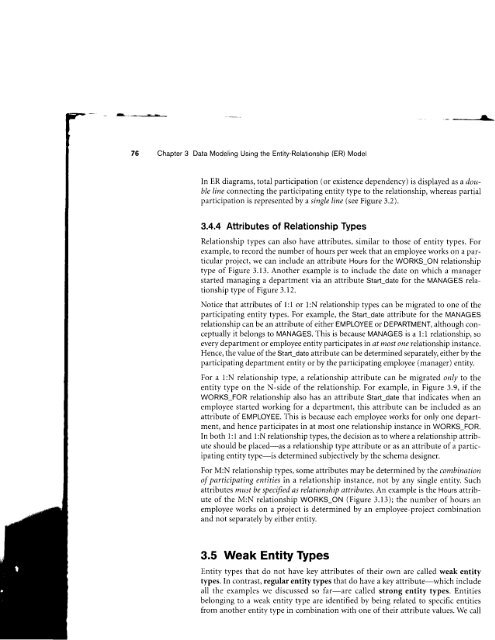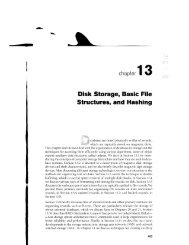this pdf excerpt
this pdf excerpt
this pdf excerpt
Create successful ePaper yourself
Turn your PDF publications into a flip-book with our unique Google optimized e-Paper software.
Chapter 3 Data Modeling Using the Entity-Relationship (ER) Model<br />
In ER diagrams, total participation (or existence dependency) is displayed as a double<br />
line connecting the participating entity type to the relationship, whereas partial<br />
participation is representedby a single line (see Figure 3.2).<br />
3.4.4 Attributes of Relationship Types<br />
Relationship types can also have attributes, similar to those of entity types. For<br />
example, to record the number of hours per week that an employee works on a particular<br />
project, we can include an attribute Hours for the WORKS_ON relationship<br />
type of Figure 3.13. Another example is to include the date on which a manager<br />
started managing a department via an attribute Start-date for the MANAGES relationship<br />
type of Figure 3.12.<br />
Notice that attributes of I :1 or I :N relationship types can be migrated to one of the<br />
participating entity types. For example, the Start_date attribute for the MANAGES<br />
relationship can be an attribute of either EMPLOYEE or DEPARTMENT, although conceptually<br />
it belongs to MANAGES. This is because MANAGES is a l:1 relationship, so<br />
every department or employee entity participates in at most one relationship instance.<br />
Hence, the value of the Start-date attribute can be determined separately, either by the<br />
participating department entity or by the participating employee (manager) entity.<br />
For a 1:N relationship type, a reiationship attribute can be migrated only to the<br />
entity type on the N-side of the relationship. For example, in Figure 3.9, if the<br />
WORKS-FOR relationship also has an attribute Start_date that indicates when an<br />
employee started working for a department, <strong>this</strong> attribute can be included as an<br />
attribute of EMPLOYEE. This is because each employee works for only one department,<br />
and hence participates in at most one relationship instance in WORKS_FOR.<br />
In both 1: I and l:N relationship types, the decision as to where a relationship attribute<br />
should be placed-as a relationship type attribute or as an attribute of a participating<br />
entity type-is determined subjectively by the schema designer.<br />
For M:N relationship types, some attributes may be determined by the combintttion<br />
of participating entities in a relationship instance, not by any single entity. Such<br />
attributes must be specified as relationship attributes. An example is the Hours attribute<br />
of the M:N relationship WORKS_ON (Figure 3.13); the number of hours an<br />
employee works on a project is determined by an employee-project combination<br />
and not separately by either entity.<br />
3.5 Weak Entity Types<br />
Entity types that do not have key attributes of their own are called weak entity<br />
t1pes. In contrast, regular entity types that do have a key attribute-which include<br />
all the examples we discussed so far-are called strong entity types. Entities<br />
belonging to a weak entity type are identified by being related to specific entities<br />
from another entity type in combination with one of their attribute values. We call<br />
_L-














